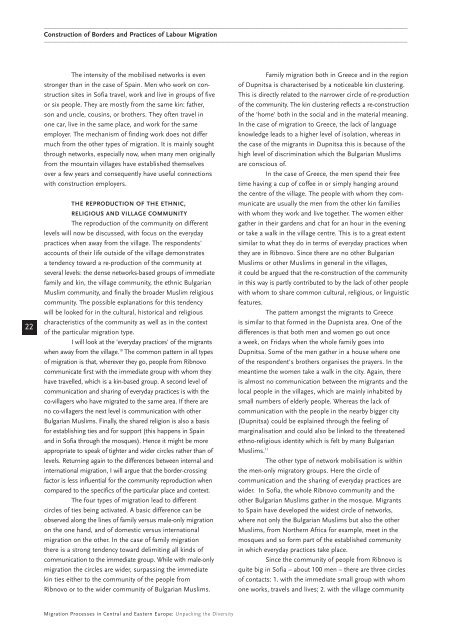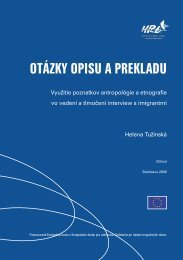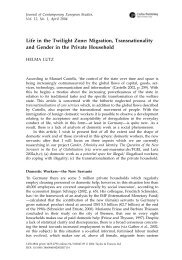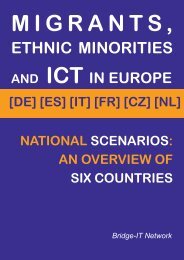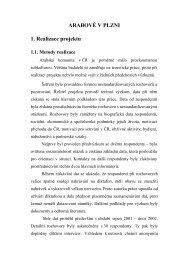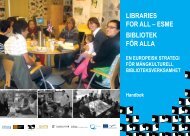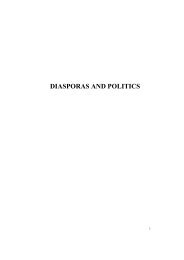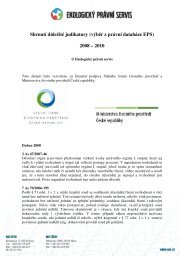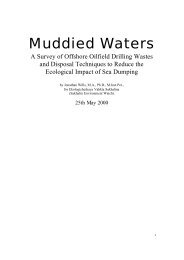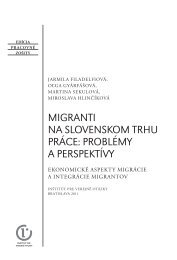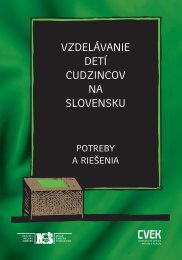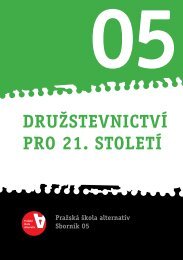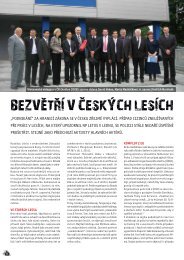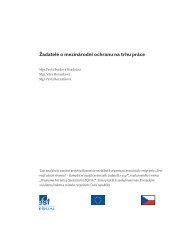Migration Processes in Central and Eastern Europe - Multiple Choices
Migration Processes in Central and Eastern Europe - Multiple Choices
Migration Processes in Central and Eastern Europe - Multiple Choices
Create successful ePaper yourself
Turn your PDF publications into a flip-book with our unique Google optimized e-Paper software.
———————————————————————————————————————————————————————————————<br />
Construction of Borders <strong>and</strong> Practices of Labour <strong>Migration</strong><br />
———————————————————————————————————————————————————————————————<br />
22<br />
The <strong>in</strong>tensity of the mobilised networks is even<br />
stronger than <strong>in</strong> the case of Spa<strong>in</strong>. Men who work on construction<br />
sites <strong>in</strong> Sofia travel, work <strong>and</strong> live <strong>in</strong> groups of five<br />
or six people. They are mostly from the same k<strong>in</strong>: father,<br />
son <strong>and</strong> uncle, cous<strong>in</strong>s, or brothers. They often travel <strong>in</strong><br />
one car, live <strong>in</strong> the same place, <strong>and</strong> work for the same<br />
employer. The mechanism of f<strong>in</strong>d<strong>in</strong>g work does not differ<br />
much from the other types of migration. It is ma<strong>in</strong>ly sought<br />
through networks, especially now, when many men orig<strong>in</strong>ally<br />
from the mounta<strong>in</strong> villages have established themselves<br />
over a few years <strong>and</strong> consequently have useful connections<br />
with construction employers.<br />
THE REPRODUCTION OF THE ETHNIC,<br />
RELIGIOUS AND VILLAGE COMMUNITY<br />
The reproduction of the community on different<br />
levels will now be discussed, with focus on the everyday<br />
practices when away from the village. The respondents'<br />
accounts of their life outside of the village demonstrates<br />
a tendency toward a re-production of the community at<br />
several levels: the dense networks-based groups of immediate<br />
family <strong>and</strong> k<strong>in</strong>, the village community, the ethnic Bulgarian<br />
Muslim community, <strong>and</strong> f<strong>in</strong>ally the broader Muslim religious<br />
community. The possible explanations for this tendency<br />
will be looked for <strong>in</strong> the cultural, historical <strong>and</strong> religious<br />
characteristics of the community as well as <strong>in</strong> the context<br />
of the particular migration type.<br />
I will look at the 'everyday practices' of the migrants<br />
when away from the village. 10 The common pattern <strong>in</strong> all types<br />
of migration is that, wherever they go, people from Ribnovo<br />
communicate first with the immediate group with whom they<br />
have travelled, which is a k<strong>in</strong>-based group. A second level of<br />
communication <strong>and</strong> shar<strong>in</strong>g of everyday practices is with the<br />
co-villagers who have migrated to the same area. If there are<br />
no co-villagers the next level is communication with other<br />
Bulgarian Muslims. F<strong>in</strong>ally, the shared religion is also a basis<br />
for establish<strong>in</strong>g ties <strong>and</strong> for support (this happens <strong>in</strong> Spa<strong>in</strong><br />
<strong>and</strong> <strong>in</strong> Sofia through the mosques). Hence it might be more<br />
appropriate to speak of tighter <strong>and</strong> wider circles rather than of<br />
levels. Return<strong>in</strong>g aga<strong>in</strong> to the differences between <strong>in</strong>ternal <strong>and</strong><br />
<strong>in</strong>ternational migration, I will argue that the border-cross<strong>in</strong>g<br />
factor is less <strong>in</strong>fluential for the community reproduction when<br />
compared to the specifics of the particular place <strong>and</strong> context.<br />
The four types of migration lead to different<br />
circles of ties be<strong>in</strong>g activated. A basic difference can be<br />
observed along the l<strong>in</strong>es of family versus male-only migration<br />
on the one h<strong>and</strong>, <strong>and</strong> of domestic versus <strong>in</strong>ternational<br />
migration on the other. In the case of family migration<br />
there is a strong tendency toward delimit<strong>in</strong>g all k<strong>in</strong>ds of<br />
communication to the immediate group. While with male-only<br />
migration the circles are wider, surpass<strong>in</strong>g the immediate<br />
k<strong>in</strong> ties either to the community of the people from<br />
Ribnovo or to the wider community of Bulgarian Muslims.<br />
Family migration both <strong>in</strong> Greece <strong>and</strong> <strong>in</strong> the region<br />
of Dupnitsa is characterised by a noticeable k<strong>in</strong> cluster<strong>in</strong>g.<br />
This is directly related to the narrower circle of re-production<br />
of the community. The k<strong>in</strong> cluster<strong>in</strong>g reflects a re-construction<br />
of the 'home' both <strong>in</strong> the social <strong>and</strong> <strong>in</strong> the material mean<strong>in</strong>g.<br />
In the case of migration to Greece, the lack of language<br />
knowledge leads to a higher level of isolation, whereas <strong>in</strong><br />
the case of the migrants <strong>in</strong> Dupnitsa this is because of the<br />
high level of discrim<strong>in</strong>ation which the Bulgarian Muslims<br />
are conscious of.<br />
In the case of Greece, the men spend their free<br />
time hav<strong>in</strong>g a cup of coffee <strong>in</strong> or simply hang<strong>in</strong>g around<br />
the centre of the village. The people with whom they communicate<br />
are usually the men from the other k<strong>in</strong> families<br />
with whom they work <strong>and</strong> live together. The women either<br />
gather <strong>in</strong> their gardens <strong>and</strong> chat for an hour <strong>in</strong> the even<strong>in</strong>g<br />
or take a walk <strong>in</strong> the village centre. This is to a great extent<br />
similar to what they do <strong>in</strong> terms of everyday practices when<br />
they are <strong>in</strong> Ribnovo. S<strong>in</strong>ce there are no other Bulgarian<br />
Muslims or other Muslims <strong>in</strong> general <strong>in</strong> the villages,<br />
it could be argued that the re-construction of the community<br />
<strong>in</strong> this way is partly contributed to by the lack of other people<br />
with whom to share common cultural, religious, or l<strong>in</strong>guistic<br />
features.<br />
The pattern amongst the migrants to Greece<br />
is similar to that formed <strong>in</strong> the Dupnista area. One of the<br />
differences is that both men <strong>and</strong> women go out once<br />
a week, on Fridays when the whole family goes <strong>in</strong>to<br />
Dupnitsa. Some of the men gather <strong>in</strong> a house where one<br />
of the respondent's brothers organises the prayers. In the<br />
meantime the women take a walk <strong>in</strong> the city. Aga<strong>in</strong>, there<br />
is almost no communication between the migrants <strong>and</strong> the<br />
local people <strong>in</strong> the villages, which are ma<strong>in</strong>ly <strong>in</strong>habited by<br />
small numbers of elderly people. Whereas the lack of<br />
communication with the people <strong>in</strong> the nearby bigger city<br />
(Dupnitsa) could be expla<strong>in</strong>ed through the feel<strong>in</strong>g of<br />
marg<strong>in</strong>alisation <strong>and</strong> could also be l<strong>in</strong>ked to the threatened<br />
ethno-religious identity which is felt by many Bulgarian<br />
Muslims. 11 The other type of network mobilisation is with<strong>in</strong><br />
the men-only migratory groups. Here the circle of<br />
communication <strong>and</strong> the shar<strong>in</strong>g of everyday practices are<br />
wider. In Sofia, the whole Ribnovo community <strong>and</strong> the<br />
other Bulgarian Muslims gather <strong>in</strong> the mosque. Migrants<br />
to Spa<strong>in</strong> have developed the widest circle of networks,<br />
where not only the Bulgarian Muslims but also the other<br />
Muslims, from Northern Africa for example, meet <strong>in</strong> the<br />
mosques <strong>and</strong> so form part of the established community<br />
<strong>in</strong> which everyday practices take place.<br />
S<strong>in</strong>ce the community of people from Ribnovo is<br />
quite big <strong>in</strong> Sofia – about 100 men – there are three circles<br />
of contacts: 1. with the immediate small group with whom<br />
one works, travels <strong>and</strong> lives; 2. with the village community<br />
<strong>Migration</strong> <strong>Processes</strong> <strong>in</strong> <strong>Central</strong> <strong>and</strong> <strong>Eastern</strong> <strong>Europe</strong>: Unpack<strong>in</strong>g the Diversity


